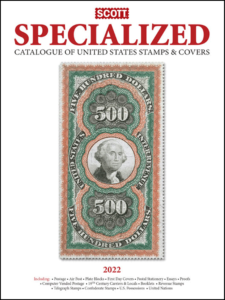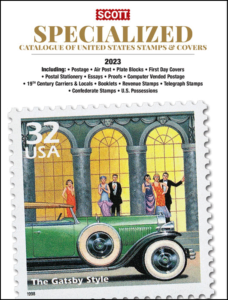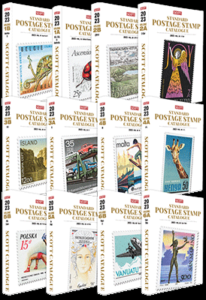The Future of Catalogues and Their Importance to The Hobby
by John M. Hotchner
It used to be that I could carry an annotated United States Scott Specialized Catalogue of the current year when I went to a stamp show. It was my record of what I had and its condition level, my want list, guidance on value, my reference on varieties to look for, and a  handy reference on design types and measurements from the first 80 years of US stamps.
handy reference on design types and measurements from the first 80 years of US stamps.
No longer! The 2022 US Specialized now weighs six pounds and stretches to over 1300 detailed and information-packed pages. In fact the entire Scott Catalogue (13 soft covered books including the Specialized, plus the 1840-1940 hardcover Classic Specialized), now takes a foot and a half of shelf space and weighs in at about 58 pounds.
I recently had to bring the catalogues from one floor to another so a dealer doing an evaluation could have them for handy reference. It took three trips! And don’t get me started on the price – just under $1000 for the complete run.
Is it any wonder that as the newly updated catalogues come out each year, prior year’s catalogues – deeply discounted – are eagerly sought by collectors who are satisfied to  have a reference for most of what is in their collections.
have a reference for most of what is in their collections.
Given that the catalogues are an essential for any serious collector, and that they can only grow as the nations of the world pump out ever more stamps and souvenir sheets even as mail volumes decrease, I got to wondering about their future.
I’m on the margins of the digital revolution and prefer looking at hard copy, but Scott has now converted the catalogues to digital form – and offers them in addition to hard copy at about three quarters the price of hard copy. But this is still a stretch for even established collectors who would much rather spend that kind of money on stamps for their own collections.
For the present time, Scott continues to sell both hard copy and digital, but how long can  they afford to produce and sell hard copy at an affordable price, as digital takes hold and eats into those sales? It is bound to happen that fewer and fewer hard copies will be sold each year, and there will come a time that hard copy will go away. I don’t have Scott’s sales numbers, but it seems logical that Scott will get to a point where only digital will be available.
they afford to produce and sell hard copy at an affordable price, as digital takes hold and eats into those sales? It is bound to happen that fewer and fewer hard copies will be sold each year, and there will come a time that hard copy will go away. I don’t have Scott’s sales numbers, but it seems logical that Scott will get to a point where only digital will be available.
But will the current format of digital versions of the full catalogues match up with collector demand? Possibly for some time to come, as we are used to this as the retail model. But I think back to the old Minkus Catalogs which briefly gave Scott some competition in the 1960s into the early 1970s. In a way it was doomed from the start as Scott numbers were the industry standard, but Minkus album pages were popular. Labeled with Minkus catalog numbers, they helped to sell the catalog.
But Minkus did something that I wish Scott would consider: Minkus brought out a series of country-specific catalogs. Undoubtedly, that negatively affected sales of the
comprehensive catalogs. They were not updated yearly, but it was a real service to collectors who specialized in one or only a few countries, and saved megabucks for collectors who did not need the comprehensive catalogs.
Scott is a business, and I don’t minimize the cost of providing the products they do. I’m sure that the economics of catalogue production are unforgiving. They put a terrific amount of human effort and investment into keeping their products up to date, and it is right and proper that they cover those costs with their pricing, and that they make a profit. But I am troubled by what catalogues – hard copy and digital – cost the collector.
At the same time that the products are an essential for the hobby, they are as a practical matter not available to the great majority of people who might be interested in getting started in stamp collecting – especially young people who are still in school or just starting  out in a career.
out in a career.
Does this play a role in the steadily decreasing market share that stamp collecting commands these days? I think so. Sure, there are other factors involved in that: the delayed gratifications of stamp collecting can’t hope to compete with the immediate gratifications of video games. But we as a hobby are not making it easy for new people to join up and prosper when the tools of the hobby are priced beyond what new collectors can afford.
To repeat, Scott must cover its costs and make a profit or we will lose the substantial benefits of having the continually updated critical reference upon which we all depend. But I hope they also factor in somehow, (may I call it) their responsibility to also support the future of the hobby.
If this means they bring out hard copy only every two years, or alternate years between hard copy and digital, or a host of other possible ways to cut costs for both producer and user, they are worth thinking about.
Should you wish to comment on this editorial, or have questions or ideas you would like to have explored in a future column, please write to John Hotchner, VSC Contributor, P.O. Box 1125, Falls Church, VA 22041-0125, or email, putting “VSC” in the subject line.
Or comment right here.





What you didn’t mention is to buy a digital-only version of the Scott catalogues requires one to have to put up nearly $800 a year, every year, if they want continuous access to the complete set including both specialized volumes. I would expect most collectors and even smaller dealers did not buy all the catalogs every year, maybe every three or four. This pricing strategy seems to intend to actually discourage migration to the digital realm by making it prohibitively costly. Michel and Yvert’s digital access to their catalogs is much more reasonably priced – but they don’t update all their catalogs every year so don’t have as much expense as Scott has to recoup. Unfortunately collectors in the USA have little recourse other than to use the Scott numbering system. At some point Scott will no longer support the old format digital 2020s I have and then I honestly don’t know what I will do. I’m young enough that I prefer the digital access – I need my workspace for stamps, not catalogs! It will be interesting to see what direction Scott takes.
I was amused to see on the Amos Media sales website Amos Advantage (Amos is the parent company of Scott Publishing) that its price for the 2023 Specialized is $104.99 but if you hurry, you can still get a copy of the 2022 edition….also for $104.99. Why on earth would you want the older edition if it’s the same price?
You’re absolutely right about the cost being prohibitive. I did buy a set of 2022s but doubt that I’ll ever buy another set as I can always, for the foreseeable future. Use library copies. I don’t collect a lot of recent stamps aside from certain US stamps that fit my topics. I also have considered subscribing to Linn’s Stamp News but $119 or whatever is about 1/2 of a month’s groceries. Like you I know these companies have to cover costs and make a profit. But they are pricing us out which means they lose customers which affects their sales etc. I can’t use the digital editions for long because of vision problems. I don’t know what will happen with Amos and Scott or even Linn’s but I’m pretty sure, unless I play the lottery and win, I’ll no longer be a customer
I wish Scott’s/Amos would go visit various Stamp clubs and actually ask them for input.
As a rule of thumb, i purchase a new copy around every 2 years, Easier on the money and that is good for me, i then attempt to sell the old copy as well!
I have a complete set of the 2020 digital catalogs. Bought the 2022 Volume 1 and now I am subscribed to the 2023 Volume 3. What I normally do is replace one volume every year. Next year I will cancel Volume 3 subscription and get a volume 2 subscription. I feel if they lowered the complete set subscription to about $300 a year they would get a lot more subscription and since they don’t need to print the catalogues they should make a pretty good profit. I subscribe to Beckett’s Digital Sports Cards and that’s about what they charge and they actually have a database and not PDF files so it makes searching so much easier.
AGREE
Also my local library has the entire set for the present year as Reference and the old set in circulation, so I usually take the latest circulated catalog and scan the pages I need on my computer.
I think it’s wrong to call Scott the American “bible.” They are so far behind the actual market that can’t be possible. They are slowly adjusting the classics but try buying or selling post 1940 at their “retail”.
I think it’s the “bible” because it identifies and labels all U.S. stamps, and decides which varieties are important and of what sort they are. No other entity (corporation, publisher, society) is fulfilling that function now.
As for values (which are of little concern to me personally, since I don’t collect classic or high-sales-value U.S.) it is a “zero-sum” game IMHO. Many dealers advertise that they sell at “xx% of Scott.” Well, if many dealers are doing so, that lowers the retail value, so Scott lowers its values and the cycle starts again. For example, Scott says Stamp A’s value, based on actual prices, is $10. Dealers sell it at 80% of Scott, so the actual price becomes $8. Scott then says Stamp A’s value is $8 and dealers start selling it at $6.40…and so on.
I am 75 and a life long collector. I have always focused my collecting on United States stamp ONLY! Why would I even consider the incredible cost of a worldwide stamp publication. A senior’s budge would NEVER permit it. The best solution is publishing by country.
The Answer to a New Scott catalog? Being a member of a Stamp Club that lets you borrow a particular catalog between meetings, and at the next meeting either renew the borrow, or borrow a different chapter. Next is a City Library with a Scott Catalog in the Reference section. ( I have to Pay City Taxes – I will use the services… ) Last is a catalog from several years back being sold on eBay/Amazon, usually by libraries or publisher’s warehouses, at well below the Manufacturer’s Suggested Retail price, and then printing-out and adding-in my annual ‘USPS Stamp List’ for the years the catalog doesn’t cover.
Will Amos go out of business? ( To Many Stamps from each country increasing the work-load… ) I don’t know. Time to go to the beach here on Kaui’i. Aloha!